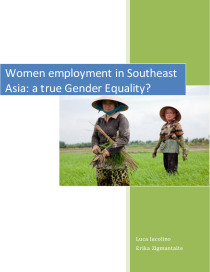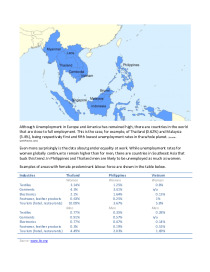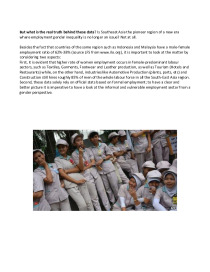Women Employment In Southeast Asia: A True Gender Equality?



Industries Thailand Philippines. But what is the real truth behind these data. Informal employment when women get even more vulnerable. Gender equality at work an achievable goal. Equal access at work by women and men.
Although Unemployment in Europe and America has remained high, there are countries in the world that are close to full employment. This is the case, for example, of Thailand (0.62%) and Malaysia (3.4%), being respectively first and fifth lowest unemployment rates in the whole planet. (source: worldfinance.com)
Even more surprisingly is the data about gender equality at work. While unemployment rates for women globally continue to remain higher than for men, there are countries in Southeast Asia that buck this trend. In Philippines and Thailand men are likely to be unemployed as much as women.
Examples of areas with female-predominant labour-force are shown in the table below.
First, it is evident that higher rate of women employment occurs in female-predominant labour sectors, such as Textiles, Garments, Footwear and Leather production, as well as Tourism (Hotels and Restaurants) while, on the other hand, industries like Automotive Production (plants, parts, etc) and Construction still hires roughly 85% of men of the whole labour force in all the South-East Asia region.
Second, these data solely rely on official stats based on formal employment; to have a clear and better picture it is imperative to have a look at the informal and vulnerable employment sector from a gender perspective.
In developing countries, where jobs in officially licensed enterprises are scarce, much of the population makes a living by working outside the official tax and regulatory systems. Although the informal sector is an important source of jobs, income and even housing, its participants lose their full rights as citizens by operating outside the legal economy. This legal vulnerability affects women particularly because so many are employed in the informal sector worldwide. And Southeast Asia is no exception. Some of the biggest countries that belong to this region have shown the urge to face the hardest challenges, as the examples below show.

















